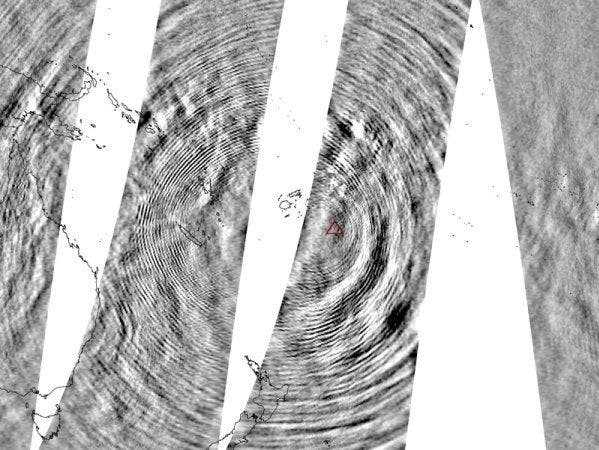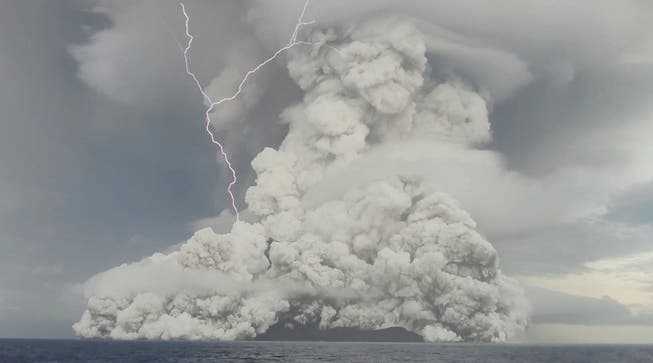The fact that the eruption made waves in all oceans was due to two different mechanisms. The explosive eruption also produced remarkable meteorological phenomena.
The violent eruption phase of the Hunga Tonga-Hunga Ha’apai volcano began on January 14 (photo) and culminated in an exceptionally powerful explosion on January 15 with an extremely large number of lightning bolts.
Scientists noticed just a few hours after the big eruption that the effect was different than usual. After the Hunga Tonga-Hunga Ha’apai volcano erupted in a highly explosive manner on January 15, the Pacific coast tsunami warning centers calculated when the expected waves would hit.
But in various places the tsunamis started minutes to hours earlier. In Japan, the first waves were observed about 7.5 hours after the eruption, Kenji Tanaka of the Hiroshima Institute of Technology wrote in an email. That was 3 to 4 hours earlier than expected.
landslides and shock waves
There were tsunamis that day due to two different mechanisms, explains ocean researcher Ivica Vilibic from the Rudjer Boskovic Institute in Zagreb. On the one hand due to landslides during the eruption – these waves were strongest in the Pacific, relatively close to the volcano. On the other hand, tsunamis were also caused by the atmospheric shock wave. The latter is very unusual.
The second mechanism not only explains why the tsunamis hit Japan so early — the shock wave travels through air at the speed of sound. This process is also the reason why, after the outbreak, tsunamis were observed even in places that they could not have reached by normal means, i.e. via the ocean, from the Pacific – for example in the Mediterranean Sea, where the sea level also fluctuated erratically. According to Vilibic, these waves reached a height of 20 to 40 centimeters in the Balearic Islands.
As a rule – this is Mechanism 1 – tsunamis are caused by seaquakes that displace huge amounts of water within seconds. Where the sea is deep, tsunamis travel horizontally at a rate of several hundred kilometers per hour. The height of a single wave is only a few centimeters to decimeters. Only on the flat coast do they slow down and pile up.
Meteotsunamis in the Mediterranean Sea
Volcanic eruptions can also cause tsunamis due to earth movements. This usually happens due to submarine landslides that displace large masses of water. This mechanism can explain the meter-high tsunamis in the area around the Tonga archipelago – but not why the waves occurred in the Mediterranean.
The solution to the riddle is called Meteotsunami. This is what earth scientists call a mechanism that generates tsunamis from the atmosphere. Meteotsunamis are usually caused by the weather: some changes in air pressure have such a strong effect on the sea that a tsunami occurs – without any action on the part of the earth.
For example, the Meteotsunami that occurs again and again near Ciutadella on Menorca, which is called Rissaga and can reach an amplitude of more than one meter, is well known. The shape of the bay and harbor makes the place particularly vulnerable to this natural phenomenon.
A volcanic eruption that triggered Meteotsunamis has only been observed once – in 1883, during the eruption of Krakatoa. At that time, too, the waves hit many coasts earlier than could be explained by the purely oceanic tsunami theory. And although the eruption occurred between Sumatra and Java, tsunamis were observed even in the Atlantic. Apparently the same phenomenon as with Krakatoa has now occurred again.
energy from the atmosphere
Tonga’s explosive eruption, with a force equal to more than 500 Hiroshima bombs, created a special air pressure wave in the atmosphere. It is called the Lamb wave, after the British mathematician Horace Lamb. This wave spread around the globe in an ever-growing circle at a speed of around 1100 kilometers per hour.
for #FullDiskFriday, we are highlighting the massive atmospheric shockwave produced by the #Tonga volcanic eruption on January 15. Seen here in this #GOESWest water vapor loop, the shockwave pushed across the Pacific and reached the US in just a few hours. pic.twitter.com/2eyEyWEOfL
— NOAA Satellites (@NOAASatellites) January 21, 2022
In certain sea regions, the physical phenomenon of resonance occurred: at a suitable water depth, the sea was stimulated by the Lamb wave to form tsunamis. “When the speed of the atmospheric waves is roughly the same as the speed of the tsunamis, energy is constantly being pumped out of the atmosphere into the ocean,” explains Ivica Vilibic, who has researched Meteotsunamis intensively. If the agreement is poorer, the resonance is much weaker.
In Japan, the Lamb wave arrived about 10 to 30 minutes before the first tsunamis. Kenji Tanaka sees this as evidence that the Lamb wave was the trigger. More tsunamis later reached Japan. According to Tanaka, these included those caused by submarine landslides. Luckily, the height of the tsunamis on the coasts of Japan was only a few centimeters.
Extremely many flashes
The Tonga eruption was also exceptional for other, purely meteorological, reasons. According to the latest evaluation of satellite images, the eruption cloud reached a height of around 55 kilometers, according to Simon Proud from the Rutherford Appleton Laboratory in Oxfordshire on twitter reported. Such a high eruption had never been measured before. Friction of particles in the eruption cloud caused 400,000 lightning discharges – also more than has ever been recorded.
1-min CG lightning plot of #Tonga eruption pic.twitter.com/Dt0exOhvG7
— William Churchill (@ChurchillWx) January 15, 2022
The unusual atmospheric wave phenomena that scientists have observed in connection with the eruption should also cause a lot of discussion. Measurements with infrared sensors on satellites reveal a concentric pattern of atmospheric “gravity waves” on the screen of the eruption cloud. Everyone is familiar with gravity waves as a physical phenomenon, because this type of wave also includes ordinary water waves.
Such a pattern of atmospheric gravity waves had not been observed in previous volcanic eruptions. Researchers assume that it – like the other phenomena – can be explained by the unusual intensity of the eruption.

Gravity waves triggered by the eruption can be seen in this image using an infrared sensor on NASA’s Aqua satellite.
One thing is already becoming apparent: Not only a number of studies will soon be published on the Tonga volcanic eruption, but also many master’s theses and dissertations to describe and explain the multitude of unusual phenomena.
